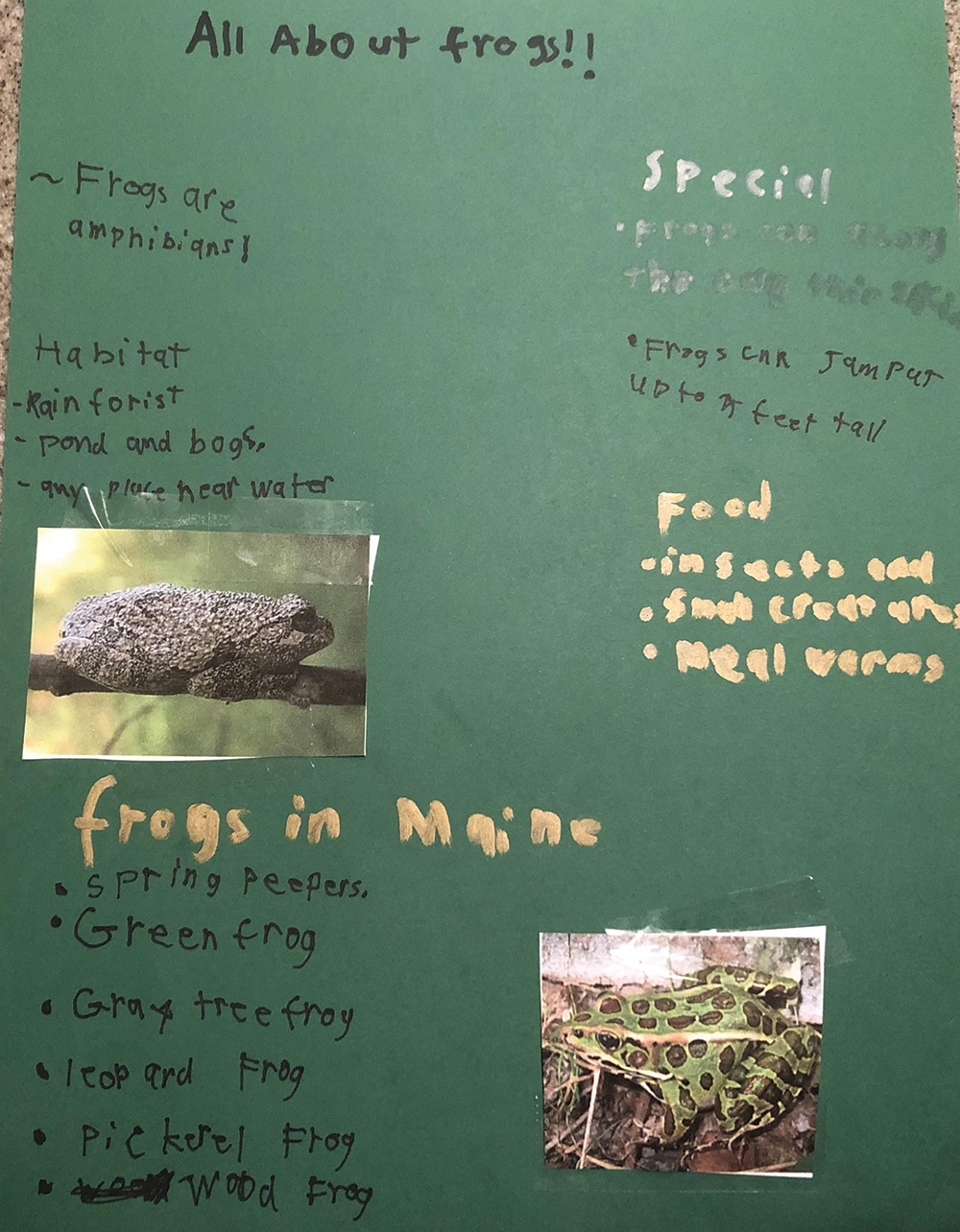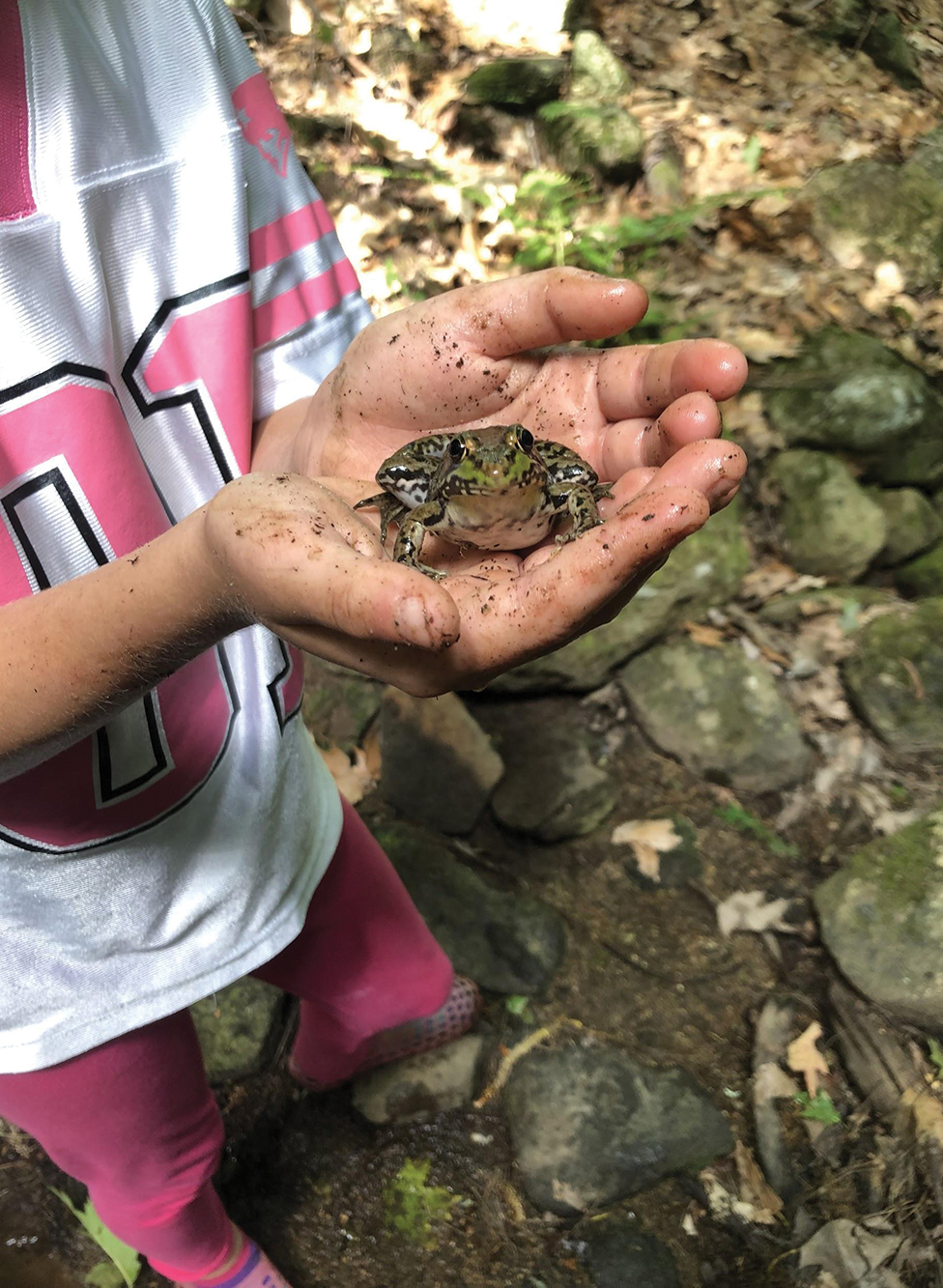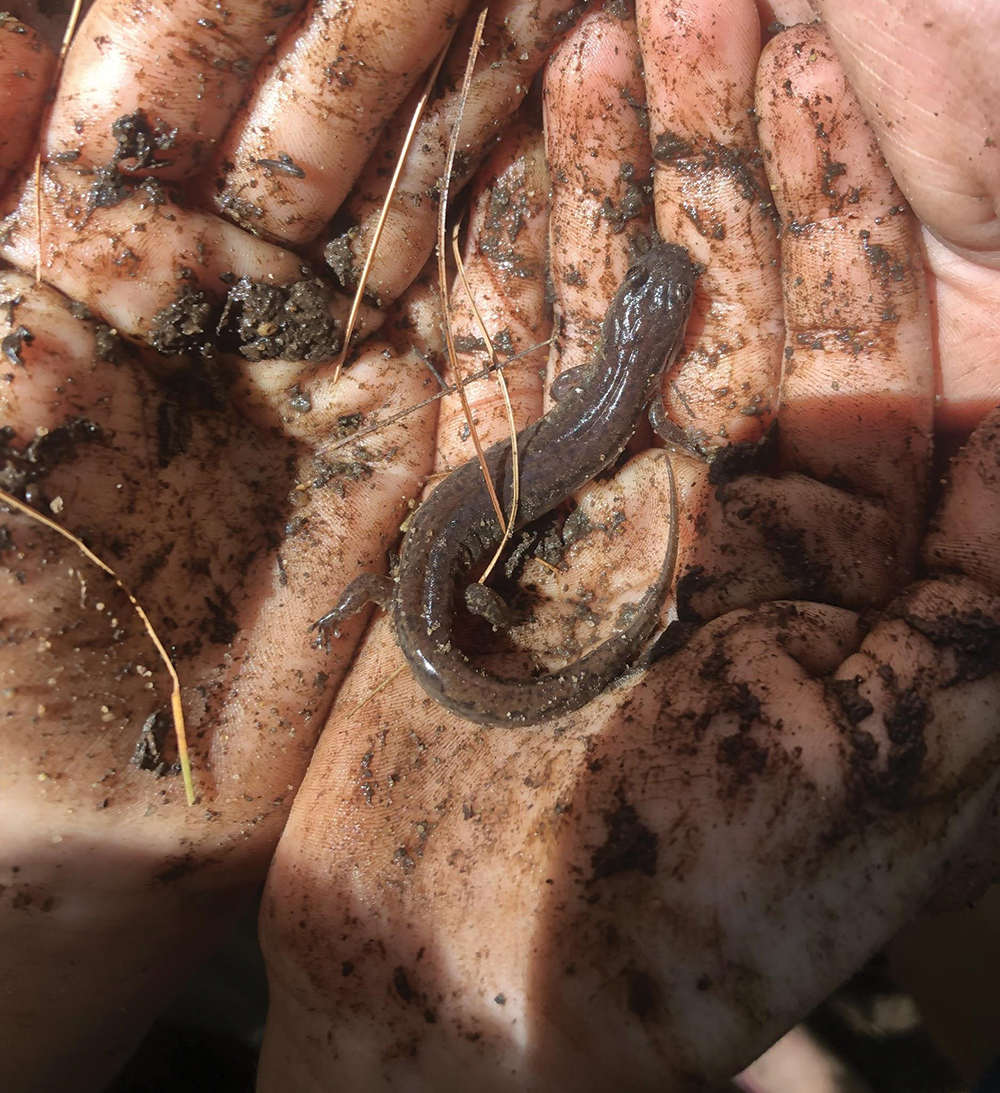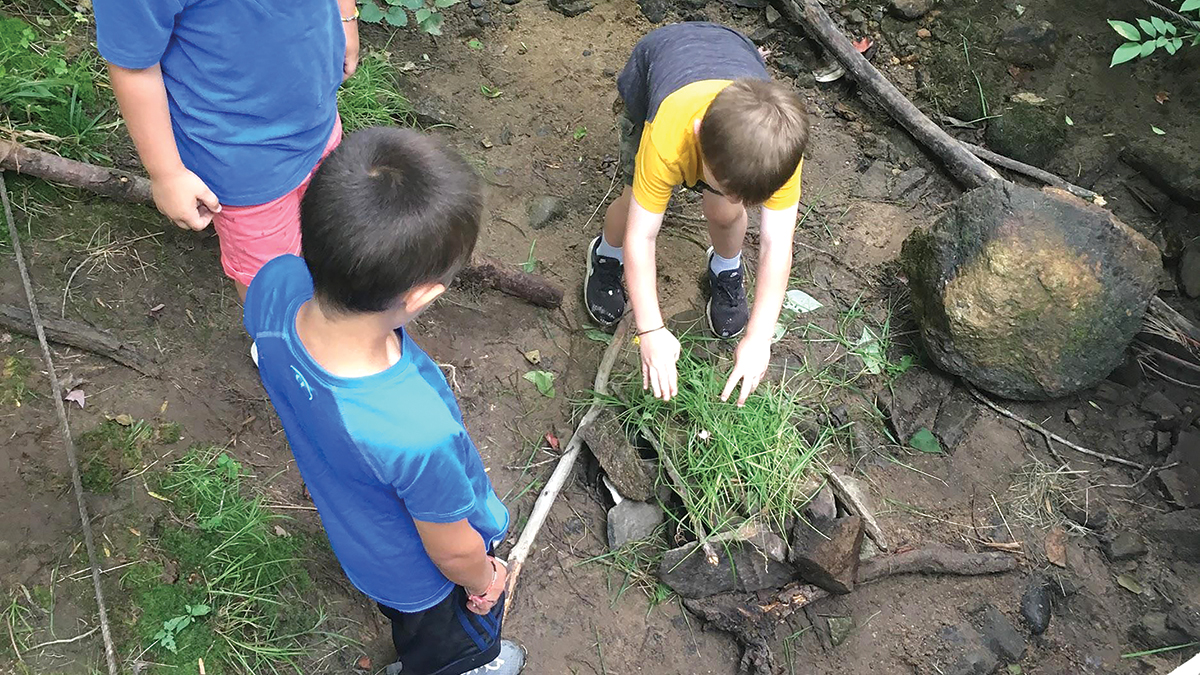Feature
Frogs Need Homes and Other Ecological Lessons
Learning about and building habitats for amphibians
Have you ever touched a frog or salamander? Most students have never had the opportunity to interact with amphibians. Field trips students list as most memorable are usually their outdoor experiences and interactions with living creatures. Apart from being memorable, field trips need to be meaningful and provide students with authentic learning experiences. Field trips allow students to actively engage in science while exploring, experiencing, and expanding their understanding of their environmental community. During this unprecedented time of remote learning, field trips can be an exciting opportunity to engage children in learning about science and the world around them. This article describes how field trips to a local nature preserve provided third- and fourth-grade students with opportunities to study amphibians, learn how hazards are causing a decrease in their population, and engineer solutions to help. Though this field experience was implemented at a nature preserve, it could easily be completed near any freshwater environment. This week-long field experience for children could be adapted for our current situation of remote learning under the guidance of adults.
By identifying different species of amphibians and learning about their habitats, students became more aware of the importance of amphibians in the ecological environment. STEM practices were implemented through Bybee’s (2019) 5E instructional model. In the explore and explain sections of the field experience, students developed scientific knowledge of amphibians and their environment. In the extend and evaluate stages, students are involved in a STEM activity. They acted as engineers and used their acquired knowledge to plan, design, and construct habitats for amphibians.
Day 1
Engagement: Introduction to Amphibians (15 minutes)
The summer program experience began with exploring the life cycle of a frog in a classroom aquarium. Students observed and recorded the growth of tadpoles using their summer journals and graph paper each morning for about six weeks. Since many of the tadpoles were becoming froglets, I explained that we would need to release them. I empowered students to work like scientists by discussing in groups what they thought the word habitat meant. Asking questions and listening to students’ discussions allowed me to preassess their knowledge and address misconceptions. Here were some of the students’ responses: Student 1: It’s a place where an animal lives. Student 2: I think it’s the things that an animal needs to survive.
After this, I asked students to think about where a frog’s habitat might be and where we should release our froglets.
- Student 3: A frog’s habitat is a pond because they need to stay in the water to live.
- Student 4: But there are different frogs. Some like to be in the mud or trees and some like to be in the water.
I then had students record their answers in their summer journal. I explained to students that we would learn about some of the amphibians native to Maine and their habitats.
Expanding Knowledge (45 minutes)
After my introduction, students learned about amphibians by watching a video. We reviewed the different amphibians: frogs, toads, salamanders, and newts. Then we reviewed vocabulary words mentioned in the video like amphibian, carnivore, herbivore, vernal pool, oviparous, and metamorphosis. After introducing them to the basics of amphibians, students chose one to research. Their task was to create a poster and share with their classmates what they had learned. The guidelines for the posters were: students needed to describe the chosen amphibian, their habitat, their diet, and an example found in Maine. Figure 1 demonstrates students’ understanding of the amphibians they had researched.

Student posters.

Student holding a green frog.
After students had completed their posters, a discussion ensued in which students explained the differences and similarities among the various amphibians by using a class Venn diagram.
Days 2 and 3
Explore: Field Experiences (45 minutes each day)
At the preserve, there were two streams as well as a vernal pond with a high population of frogs, toads, and salamanders. For the next two days, we went to these habitats to catch amphibians and record data. Having a support technician with me allowed for a 6:1 student to teacher ratio. Boundaries were established by using orange safety cones to delineate approved working areas. Students were not allowed to go into the water, and each adult had a first-aid kit with them at all times.
Once we reached the designated search area of the preserve, I announced that students’ hard work researching amphibians allowed them to step into the role of herpetologist on the preserve. Discussing what a herpetologist was reinforced our learning goals. As herpetologists, students would catch (or at least take a picture of) amphibians, identify the species, describe its habitat, and record scientific observations in their journals.
Each day before heading to the preserve, we talked about safety precautions. I reminded students that they were “guests of nature” in the amphibians’ homes and this helped develop a respect for living creatures and their environments. Table 1 shows the safety precautions they created.
| Table 1. Safety precautions. | ||||||||||||
|---|---|---|---|---|---|---|---|---|---|---|---|---|
|
In this multi-sensory activity, students not only located species visually but also located them by listening for the sounds they produced. The unique calls of spring peepers and bullfrogs helped students locate them.
Initially, some students exhibited discomfort with handling amphibians. Some had misconceptions that amphibians would give them warts or make them sick; others just feared amphibians because they had no prior experience with them. In Maine, there is only one amphibian, the red eft, which is poisonous when ingested. For the past few years, I have volunteered at a reptile and amphibian rehabilitation center. Hence, I developed a love for the cold-blooded animals! By modeling my comfort with amphibians to the students, I quickly observed that most became eager to attempt holding amphibians.
Explain: Sharing Discoveries (15 minutes each day)
At the end of the class, we looked at the “Amphibian book” I created, which was inspired by Leclair’s amphibian migration resources to identify the different species caught. Each page was dedicated to a specific species of amphibian and included pictures, tricks to identify the species, and more information about them (i.e., habitat, food). Students used this book and their observations to document in their journals the amphibian they identified, its habitat, and record other discoveries made. Students requiring support for fine motor used a voice recording app for documentation.
After journaling, students shared their experiences and made connections between the various species and habitats in which they had been found. Students used this information to add additional information to the Venn diagram.
Days 4 and 5
Extend: Building a Habitat (90 minutes total)
After two days of observing and exploring, I shared with students that almost half of the amphibian populations in Maine are declining and more than a quarter are facing extinction. One possible reason for this is when amphibians are traveling to vernal pools to mate, they are crossing roads and being run over by cars (Leclair 2019). Other possible reasons for the decrease are predators and habitat destruction.
We brainstormed possible solutions to help restore the amphibian population. One idea was to build habitats for amphibians to protect them from predators. I then posed the question, “Can you build a shelter for an amphibian that would protect it from predators?”
We discussed what a protective shelter was and reviewed terms like structure, stability, and durability. The children reviewed each other’s posters and the different habitats amphibians need. Students were given the following criteria: all materials needed to be from nature, all structure dimensions would fit within a one-foot cube, and all structures had to support the habitat needs of the amphibian it was designed for.
In groups, students created plans in their journals for their habitats and answered the following prompts: Where will the habitat be? Why is it a good location? Draw a picture of your structure. What will you use to build your structure? Why did you choose those materials?

Student holding a northern dusky salamander.
Each student then took a picture of their journal page and used a recording app to explain their thinking. This ensured that all students were contributing and had an understanding of the project. Once students had finished submitting their proposal, they began to construct their shelters.
While students were brainstorming their ideal habitats, I asked them these guiding questions: Why did you choose to build your shelter here? Why did you use these materials? How does this shelter help the amphibian to survive?
Evaluation: Sharing and Reflection (30 minutes)
When all students had finished the STEM activity, each group shared their shelter with the class. As students were building their habitats, I reminded them of the guiding questions mentioned above to prepare students for their presentations. Students explained why they built the shelter in the area, the design and materials used, and how their shelter protected the amphibian.
The presentation of their STEM-based projects was used as a summative assessment. I used the guiding questions as an assessment checklist to see if each student was able to describe their habitat, the amphibian, and the rationale for their materials and location based on the species. All students were able to communicate their arguments for building the amphibian shelters in a particular habitat. The students’ creative ideas and supporting reasons demonstrated their understanding.
To close, I asked students to respond to the prompt in their journals from the beginning of the week: Where should we release our froglets? I collected their journals and compared the responses to this question from the preassessment and post-assessment, and I observed growth in their understanding of amphibian species and their specific habitats. At the beginning of the experience, many students chose one habitat (mud, water, tree) for all amphibians. Through their journaling and final prompts, students began to develop a deeper understanding of the varying habitats for amphibians and their benefits. Students were able to give specific examples of different habitats depending on the individual species of amphibian they researched.
Conclusion
I was delighted that even the most hesitant students gradually became comfortable once their misconceptions were cleared and they observed positive interactions with amphibians. Once students conquered their fears of amphibians, they brainstormed solutions to help save them. Finally, they learned to respect and care for amphibians as they caught and released them back to their habitats. This field trip was not only memorable for students, but it also encouraged them as a new generation to engage in amphibian preservation.
Though this field experience was implemented at a nature preserve, it could easily be adapted wherever one lives. Educators, families, and children are all trying to navigate this unfamiliar time of remote learning. This field experience provides an incredible opportunity for children to engage in science, ELA, math, and STEM learning. Nature preserves may not be open during this time, but this activity can still be completed using any freshwater environment.
Since there is only one poisonous amphibian in Maine, I hope more teachers and families will take advantage of the opportunity during this unique time to introduce children to these harmless, abundant, and easy to find creatures which are often overlooked.
Molly McCormick (molly.mccormick@maine.edu) is a third-grade teacher at Paris Elementary School in South Paris, Maine. Carole Lee (carole.lee@maine.edu) is an associate professor at the University of Maine at Farmington.
Biology Environmental Science Life Science Elementary



